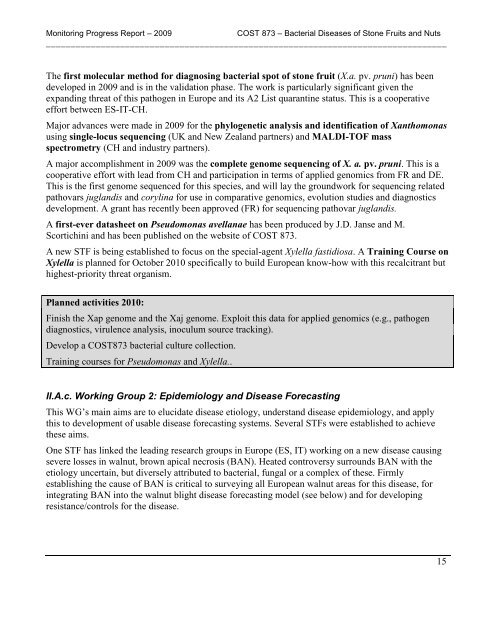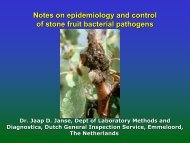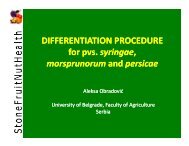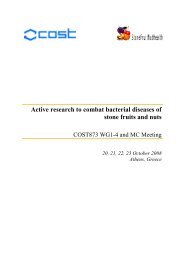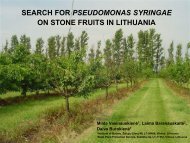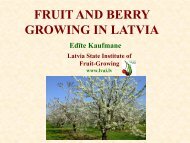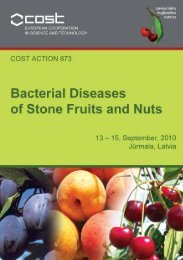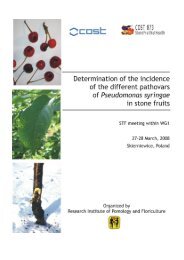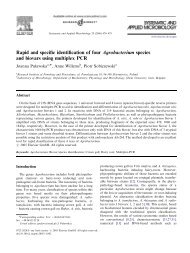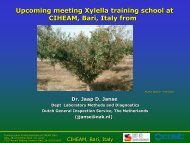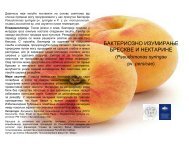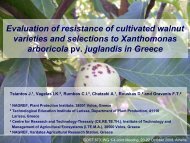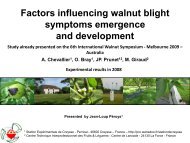Annual progress report - Cost 873
Annual progress report - Cost 873
Annual progress report - Cost 873
Create successful ePaper yourself
Turn your PDF publications into a flip-book with our unique Google optimized e-Paper software.
Monitoring Progress Report – 2009<br />
COST <strong>873</strong> – Bacterial Diseases of Stone Fruits and Nuts<br />
_________________________________________________________________________________<br />
The first molecular method for diagnosing bacterial spot of stone fruit (X.a. pv. pruni) has been<br />
developed in 2009 and is in the validation phase. The work is particularly significant given the<br />
expanding threat of this pathogen in Europe and its A2 List quarantine status. This is a cooperative<br />
effort between ES-IT-CH.<br />
Major advances were made in 2009 for the phylogenetic analysis and identification of Xanthomonas<br />
using single-locus sequencing (UK and New Zealand partners) and MALDI-TOF mass<br />
spectrometry (CH and industry partners).<br />
A major accomplishment in 2009 was the complete genome sequencing of X. a. pv. pruni. This is a<br />
cooperative effort with lead from CH and participation in terms of applied genomics from FR and DE.<br />
This is the first genome sequenced for this species, and will lay the groundwork for sequencing related<br />
pathovars juglandis and corylina for use in comparative genomics, evolution studies and diagnostics<br />
development. A grant has recently been approved (FR) for sequencing pathovar juglandis.<br />
A first-ever datasheet on Pseudomonas avellanae has been produced by J.D. Janse and M.<br />
Scortichini and has been published on the website of COST <strong>873</strong>.<br />
A new STF is being established to focus on the special-agent Xylella fastidiosa. A Training Course on<br />
Xylella is planned for October 2010 specifically to build European know-how with this recalcitrant but<br />
highest-priority threat organism.<br />
Planned activities 2010:<br />
Finish the Xap genome and the Xaj genome. Exploit this data for applied genomics (e.g., pathogen<br />
diagnostics, virulence analysis, inoculum source tracking).<br />
Develop a COST<strong>873</strong> bacterial culture collection.<br />
Training courses for Pseudomonas and Xylella..<br />
II.A.c. Working Group 2: Epidemiology and Disease Forecasting<br />
This WG‟s main aims are to elucidate disease etiology, understand disease epidemiology, and apply<br />
this to development of usable disease forecasting systems. Several STFs were established to achieve<br />
these aims.<br />
One STF has linked the leading research groups in Europe (ES, IT) working on a new disease causing<br />
severe losses in walnut, brown apical necrosis (BAN). Heated controversy surrounds BAN with the<br />
etiology uncertain, but diversely attributed to bacterial, fungal or a complex of these. Firmly<br />
establishing the cause of BAN is critical to surveying all European walnut areas for this disease, for<br />
integrating BAN into the walnut blight disease forecasting model (see below) and for developing<br />
resistance/controls for the disease.<br />
15


